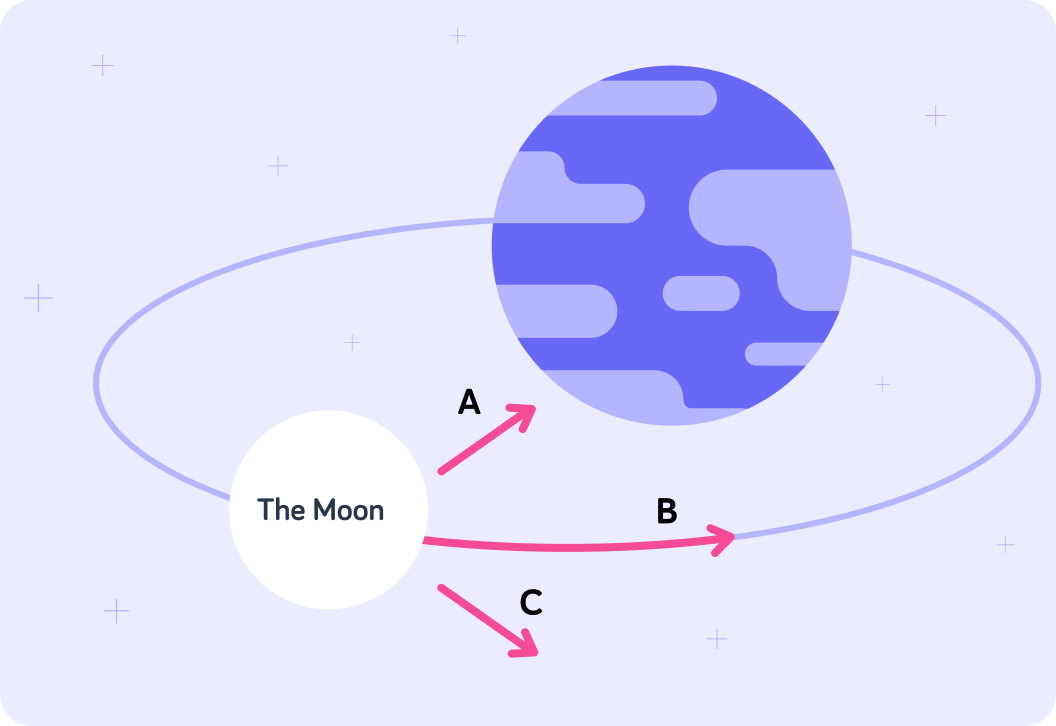YOU ARE LEARNING:
Movement in a Circle

Movement in a Circle
When an object is travelling in a circle and not a straight line, we can deduce that there is some kind of force acting on it.
According to Newton's first law of motion, unless a resultant force acts on an object in motion it will ...

To summarise Newton's first law of motion in full: Unless a resultant force acts on an object in motion, it will continue moving in a straight line at a constant velocity.
If objects continue moving in a straight line at a constant velocity in the absence of a resultant force, then why can we conclude that there is a resultant force always acting on Earth? Pick the option that is most accurate.

The image shows the force of gravity from the sun, acting on Earth. In which direction does the gravitational force from the sun, act on Earth?
A) Towards the centre of Earth B) Towards the centre of the sun C) Diagonally
Answer A, B or C.


What would happen to the motion of Earth if the pull of gravity from the sun did not exist?
A) It would move towards the sun B) It would move in the opposite direction to the gravitational force C) It would carry on moving in a straight line
Answer A, B or C.


Any object moving in a circle must have a resultant force acting upon it, otherwise it would be moving in a straight line!
In circular motion, we call this the centripetal force. The force of the sun's gravity provides the centripetal force needed to keep a planet in orbit around the sun. The term centripetal simply describes the direction of the force.
If the term centripetal simply describes the direction of a force, and the sun's gravity provides the centripetal force to keep Earth in its orbit, in which direction do you think a centripetal force always acts when an object is moving in a circle?

Which shows the centripetal force acting on the moon? Answer A, B or C.


Which shows the moon's motion if it were not for the centripetal force? We call that the "path of inertia" by the way. Answer A, B or C.


If the moon is orbiting the Earth at a constant speed, do you think its velocity remains constant also?

Any object moving in a circle is constantly changing direction, otherwise it wouldn't be a circle - it would be a straight line. This must mean that its velocity is constantly changing, as velocity is speed in a given direction.
Imagine you were holding a conker on a string. You could pull the string in such a way to cause circular motion. Circular motion simply means that the conker moves in a circle! Which force provides the centripetal force to keep the conker in circular motion?

It is not just planets and satellites in orbit which are acted on by a centripetal force. For any object moving in circular motion, there is a resultant force acting towards the centre of the circle.
If you were holding a conker on a string, you could pull the string in such a way to cause circular motion quite easily. It would take a lot more force to do the same thing with a bowling ball. What can you conclude about centripetal force and mass?

What provides the centripetal force when a car turns a corner?
When a car turns a corner, it moves in a circular path. In which direction does the resultant force on the car act?
A) In the forwards direction B) Towards the centre of the circle C) In a downwards direction
Answer A, B or C.

What do you think might provide the centripetal force?
A) Gravity B) Friction C) Tension

If a driver drives around a roundabout faster than he normally would, do you think that the centripetal force needed to keep the car in circular motion will ...
A) increase B) decrease C) stay the same

